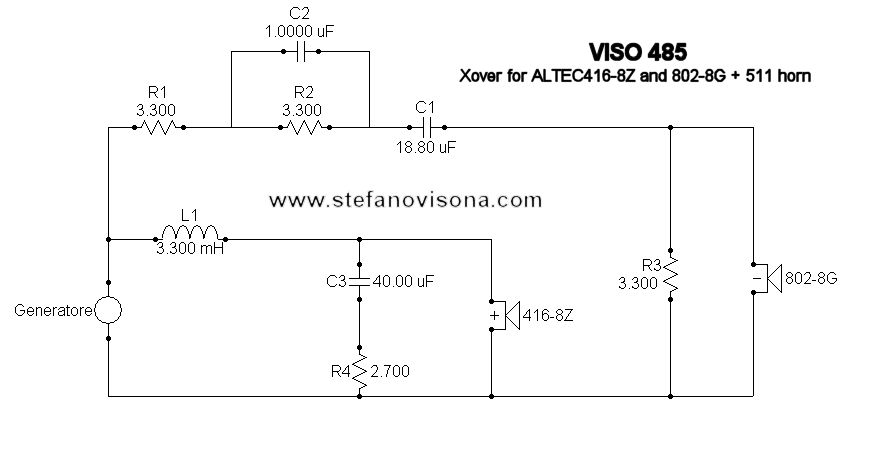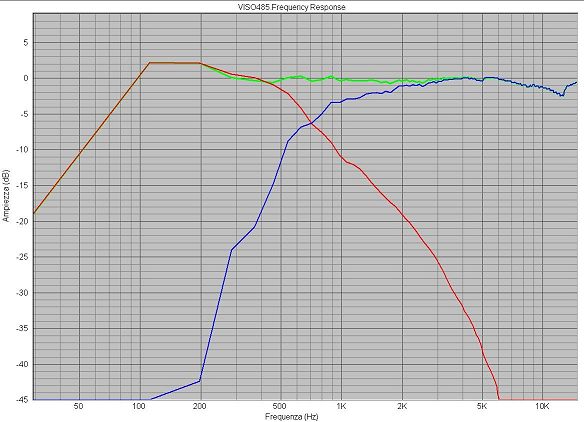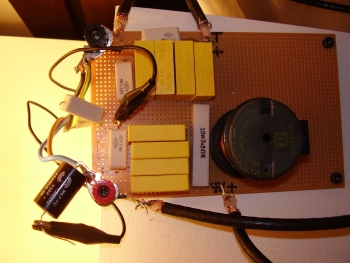| Copyright Steveviso |
VISO 4-8-5 |
|||
I think that from the crossover depends the global results of the speaker. Exceptional drivers are not enough, you should mix them correctly and obtain a good ("easy") load for your amplifier. I work about three months, simulating different crossover network, building, measuring, listening and adjusting them. The result is a non-conventional crossover for this application, with minimal but not minimum of components. There is only what is necessary, but also everything what is necessary. My first idea was to cross drivers around 700 - 800 Hz. Altec 511 horns in theory could work until 500 Hz (nominal cut-off frequency of the horn), but in such condition they sound a little bit "nasal". And I prefer not to go over 800 - 850 Hz, because crossover frequency should be too close to human voice frequencies. Wanting to try a cross around 800Hz, there are some old original Altec network that seems OK on purpose: the N800 series, 12dB/ott and the possibility to attenuate the high way. On E-bay they can be found less than 100 $, but you should consider the substitution of the condensers and, if present, of the L-pads. In the image below, the schematics of the N800D (16 Ohm), drawn from the bulletin Altec TL-121 that you can find on Altecunofficialpages.
I made some simulation to check if they could fit on my VISO 485, but result was not convincing me. After that I decided to design my own crossover network, using possibilities offered by SpeakerWorkshop in modeling networks on the real measured impedance and frequency response of my Altec drivers. I did really a lot of simulations with SW and built for testing also many networks, from second order with complex Zobel compensation to simple first order network, and I tested also crossover frequency between 600 Hz and 1000 Hz. A first order filter was more convincing me (uh, maybe it was only an audiophile mania) so, at the end, after a long period of listening and tuning the final result is:
It seems a simple first order filter, with a crossover frequency about 700 Hz (as you can read from frequency graph below). But components value are not exactly what you could obtain from classical formulas: L=(1/2*Pi*fc)*Z*10^3 and C= (1/2*Pi*fc)*(1/Z)*10^6. The effect of every component in the network has been simulated, listen, modified, optimized and it is used for final result, including Zobel and L-Pad components. I mean, C3-R4 are a typical Zobel circuit for impedance compensation of the inductive rise at high frequencies of 416-8Z. Their main scope is usually to get the impedance of woofer much more like a constant resistive value. But in this case not only, their values have been chose also to improve crossover low pass effect and modify frequency response around 400 - 500 Hz. On the high way, C1 is the high pass filter, while R1+R2 ed R3 are the L-pad network to decrease the 802-8G level by about 6 dB and to reduce impedance peak of the driver. C2 is a bypass on R2, it reduces the effect of L-Pad at high frequencies, so there is an increase on emission over 10 - 12 kHz. C2 value has been defined during listening tests in my room (simulation could not help you in this case), to get a better definition and quality at high end, that "touch of magic" that makes the system... uh ...quite perfect. In the graph below, frequency response of VISO 485, not so bad for a horn system (consider anyway that, as explained, measure under 200 Hz and over 10000 Hz are not really perfect). In the next photo, the external crossover during final tests. After that I build a better "definitive" version with glued components that I inserted inside the cabinet. I used all capacitors in polypropylene, carbon 10W resistance, wiring in OFC + silver, soldering with 2% Ag, and for L1 a core low resistance inductance. Quality of components is important, of course, but without getting crazy and spending a lot of money. I don't believe in some audiophile manias, if you want to joke with sound, try adjusting some values or testing different network topology.
|
||||
Just to finish, some Listening Notes |
||||



